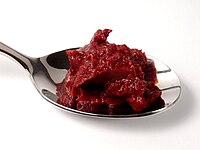
Photo from wikipedia
In the tomato juice and sauce industries, tomatoes are submitted to a hot break or a cold break thermal treatment. Tomato seed is considered waste but could become an important… Click to show full abstract
In the tomato juice and sauce industries, tomatoes are submitted to a hot break or a cold break thermal treatment. Tomato seed is considered waste but could become an important source of edible oil. A 3-year study was conducted. The studied properties were free acidity (max 1.26%), peroxide value (max 6.14 meq O2/kg oil), p-anisidine value (0.40–13.45), Totox (3.85–24.68), saponification value (187.84–198.90), total phenols (212–532 mg/kg), and refractive index (1.4707–1.4723). DPPH· was always higher than 70%. Essential fatty acids were higher than 56% of the total fatty acid methyl ester composition content. Total sterols ranged from 1,546 to 2,077 mg/kg. Policosanol were higher on 2014 harvest year. The low free acidity, peroxide value, spectrophotometric characteristics, the high phenol content, and radical scavenging activity values suggest that tomato seed oil is potentially edible. Hot break and cold break treatments did not significantly influence the physicochemical properties and the cold break is recommended because cheaper. Practical applications This study gives information about the effect on the physicochemical properties of the tomato seed oil as a food after cold break and hot break treatments. In addition, it is evidenced how the harvest year influences these parameters.
Journal Title: Journal of Food Processing and Preservation
Year Published: 2017
Link to full text (if available)
Share on Social Media: Sign Up to like & get
recommendations!